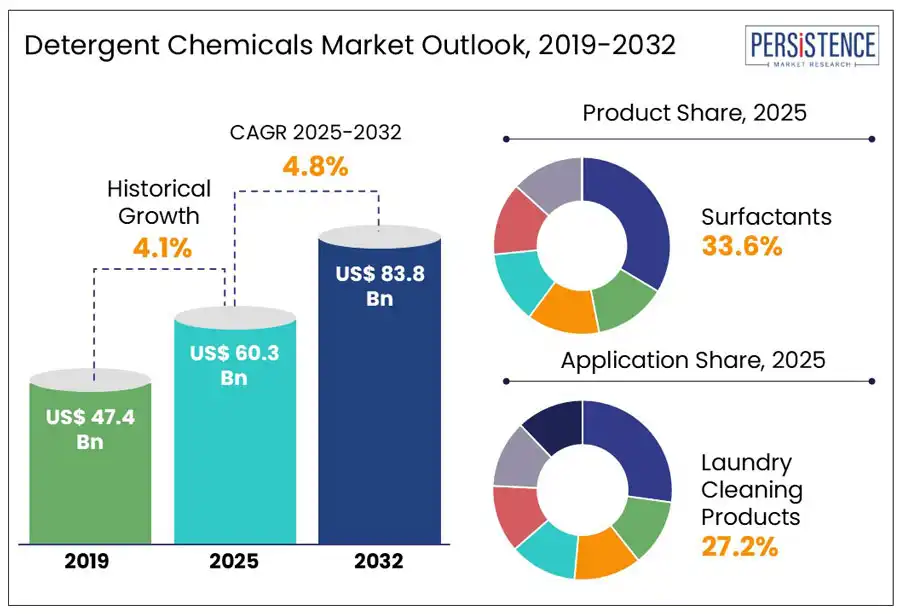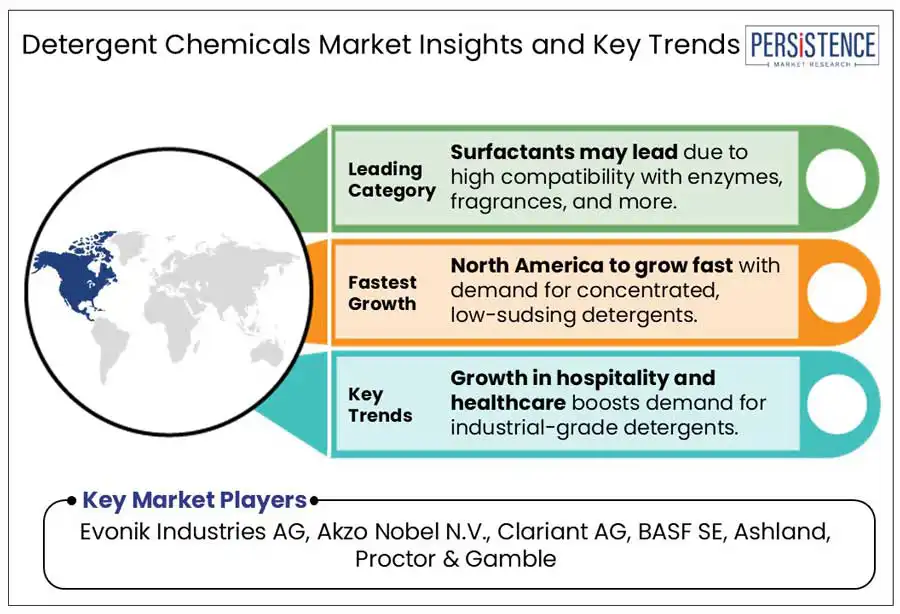Industry: Chemicals and Materials
Published Date: April-2025
Format: PPT*, PDF, EXCEL
Delivery Timelines: Contact Sales
Number of Pages: 180
Report ID: PMRREP33116
The global detergent chemicals market size is projected to rise from US$ 60.3 Bn in 2025 to US$ 83.8 Bn by 2032. It is anticipated to exhibit a CAGR of 4.8% during the forecast period from 2025 to 2032.
Increasing global focus on sanitation and hygiene is anticipated to propel demand for detergent chemicals. Transportation, food processing, hospitality, and healthcare sectors look for efficient cleaning products infused with high-quality detergent chemicals. The registration of cleaning products with disinfection claims has increased significantly, according to the U.S. Environmental Protection Agency (EPA). Several of these products rely on complex detergent chemistry to provide both cleaning and germ kill efficacy.

Key Industry Highlights
|
Global Market Attribute |
Key Insights |
|
Detergent Chemicals Market Size (2025E) |
US$ 60.3 Bn |
|
Market Value Forecast (2032F) |
US$ 83.8 Bn |
|
Projected Growth (CAGR 2025 to 2032) |
4.8% |
|
Historical Market Growth (CAGR 2019 to 2024) |
4.1% |
Demand for detergent chemicals is anticipated to rise in biological reagents owing to their key role in processes such as membrane solubilization, protein extraction, and cell lysis. These chemicals make it possible to selectively disrupt cellular membranes without denaturing proteins, which is important for procedures such as immunoprecipitation, ELISA, and western blotting.
Detergents such as CHAPS, NP-40, and Triton X-100 are set to be commonly used in protein biochemistry for the isolation of membrane proteins while conserving their original conformations. Such precision technologies are becoming increasingly important as life science research in areas including proteomics and genomics surges.
The emergence of water-saving appliances, especially high-efficiency dishwashers and washing machines, is projected to hamper detergent chemical demand to a certain extent. The way detergents interact with dirt and fabrics during cleaning is fundamentally changed by the design of these appliances. These use less water every cycle, sometimes up to 50% less than traditional variants.
Low-water circumstances are not a good fit for conventional detergent formulas, particularly those containing high-foaming surfactants, as too much suds can obstruct mechanical processes and result in insufficient rinsing. Detergent manufacturers are hence compelled to reformulate their products using highly concentrated, low-sudsing chemical compositions that function well in minimal water settings.
The manufacturing and commercialization of plant-based and biodegradable surfactants is projected to create lucrative opportunities by 2032 mainly because of stringent regulatory frameworks and rising environmental concerns. Conventional surfactants such as alkylbenzene sulfonates are mainly derived from petrochemicals and raises questions about their long-term biodegradability and aquatic toxicity. Hence, plant-based biodegradable surfactants unlocks the path to sustainable alternatives.
Key companies are anticipated to focus on introducing bio-based surfactants such as rhamnolipids and alkyl polyglucosides as these are obtained from natural sources including vegetable oils and corn glucose. Clariant’s Vita and BASF’s EcoBalanced lines, for example, were made for use in eco-label-certified detergents, lowering environmental impact and effective performance.
Detergent chemicals are projected to be extensively used as fuel additives backed by their ability to enhance engine performance by preventing deposit formation in combustion chambers and fuel injection systems. Diesel engines and Gasoline Direct Injection (GDI) are prone to carbon buildup as these operate under high pressure.
Detergent-based fuel additives are set to either dissolve or disperse these carbon deposits and help maintain engine cleanliness. Polyisobutylene amine (PIBA), for example, is considered a highly preferred detergent additive to clean fuel injectors and intake valves, thereby providing better mileage and improved engine operation.
Based on product, the global market is categorized into surfactants, builders, enzymes, bleaching agents, and fragrances. Among these, surfactants are projected to lead by holding a share of 33.6% in 2025. Surfactants can reduce the surface tension between two interacting surfaces of liquid-liquid, gas-liquid, or liquid-solid. Hence, these are extensively used as emulsifiers, foaming agents, dispersants, wetting agents, and detergents.
Enzymes, on the other hand, are projected to see considerable growth in the foreseeable future. Proteases, lipases, and amylases are few of the most preferred enzymes worldwide. All the three enzymes have different characteristics. Proteases, for instance, are utilized in laundry detergents to help remove stains such as eggs, human sweat, grass, and blood.
Companies are using lipases to help remove fatty stains including sauces, butter, lipstick, and frying fats. Lastly, amylases are finding increasing use in laundry detergents to quickly remove starchy food products such as gravies, mashed potatoes, oatmeal porridge, and spaghetti.
By application, the market is divided into laundry cleaning products, household and commercial cleaning products, personal cleaning products, dishwashing products, fuel additives, and biological reagents. Out of these, laundry cleaning products are estimated to generate a detergent chemicals market share of 27.2% in 2025, finds Persistence Market Research.
The growth is mainly due to the increasing use of gentle and multipurpose chemicals in laundry products backed by a rising focus on fabric care and color protection. To soften water and improve surfactant activity, builders such as zeolites are used in place of phosphates. Also, additives such as anti-redeposition agents witness a huge demand as they prevent dirt from settling back onto fabrics.
Household and commercial cleaning products, on the other hand, are set to witness a decent CAGR from 2025 to 2032 due to rising shift of customers toward multi-surface cleaners and kitchen degreasers that contain a wide range of chelating agents, solvents, and surfactants. These chemicals are mainly preferred due to their ability to dissolve grease, hard water stains, and organic residues effectively.

In 2025, North America’s market is projected to account for a share of around 29.6%. It will likely be pushed by rapid inclination of customers toward sustainable cleaning products as well as ongoing product innovation. The U.S. detergent chemicals market is anticipated to lead, followed by Canada through 2032.
The U.S. is set to witness a high demand for low-sudsing, concentrated detergents suitable for high-efficiency washing machines. It is projected to boost private label laundry detergent brands to utilize high-efficiency enzyme blends and non-ionic surfactants that require relatively lower dosages. Brands such as ECOS, Method, and Seventh Generation are also focusing on launching phosphate-free, plant-based detergents to comply with the EPA’s Safer Choice labeling program.
In Canada, the Canadian Environmental Protection Act (CEPA) governs chemicals, thereby encouraging the use of non-toxic and biodegradable surfactants. Local brands such as Attitude, for instance, have gained popularity with the launch of Environmental Working Group (EWG)-verified household cleaning line.
In Asia Pacific, demand for detergent chemicals is set to be propelled by modern retail penetration and rising awareness of hygiene. Unlike mature markets, the region is highly diverse with changing levels of regulatory stringency, formulation complexity, and consumption.
China’s market is projected to generate the lion’s share in 2025 as it is a significant manufacturing base for builders, enzymes, and surfactants because of high domestic use and cost effectiveness. The Made in China 2025 initiative is further anticipated to support local manufacturers to launch biodegradable detergent chemicals. Liby and Blue Moon, for example, are focusing on ramping up their production of eco-friendly lines to strengthen position.
Europe houses an environmentally conscious and highly regulated market for detergent chemicals. Germany is projected to remain at the forefront of growth in the forecast period due to the presence of various renowned detergent manufacturers such as Evonik and Henkel. These manufacturers are constantly striving to provide bio-based alternatives to traditional chemicals for detergents.
Henkel’s Persil Eco Power Bars, for example, are considered a breakthrough in washing associated with the environment. These wash capsules produce 30% less emissions than Persil Universal Kraft-Gel, the brand’s most eco-friendly product till date. Launch of similar products is anticipated to create new avenues for growth in Germany.
The global detergent chemicals market is highly competitive with the presence of several large- and medium-sized companies. They are focusing on launching new products such as safe dishwasher detergent, clean laundry detergent, and commercial dishwasher detergent.
With increasing concerns about sustainability, a few key companies are changing their manufacturing processes to include eco-friendly techniques. The market will likely see several collaborations between leading and emerging players for the co-development of clean detergent chemicals through 2032.
|
Report Attributes |
Details |
|
Historical Data/Actuals |
2019 - 2024 |
|
Forecast Period |
2025 - 2032 |
|
Market Analysis Units |
Value: US$ Bn/Mn, Volume: As Applicable |
|
Geographical Coverage |
|
|
Segmental Coverage |
|
|
Competitive Analysis |
|
|
Report Highlights |
|
|
Customization and Pricing |
Available upon request |
By Product
By Application
By Region
To know more about delivery timeline for this report Contact Sales

The market is projected to be valued at US$ 60.3 Bn in 2025.
The market is estimated to rise at a CAGR of 4.8% through 2032.
Evonik Industries AG, Akzo Nobel N.V., Clariant AG, and BASF SE are a few leading manufacturers.
The global market surged at a CAGR of 4.1% in the historical period.
Surfactants are likely to be the dominant product in the market.